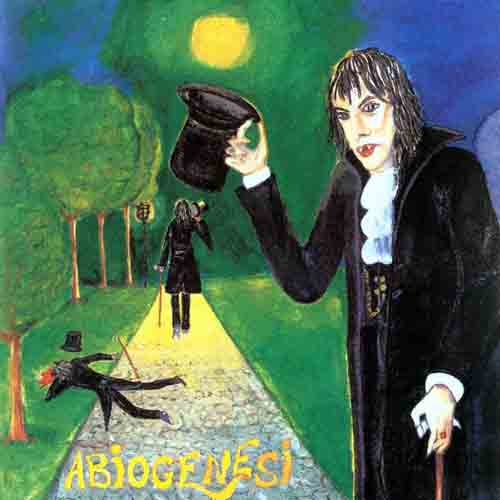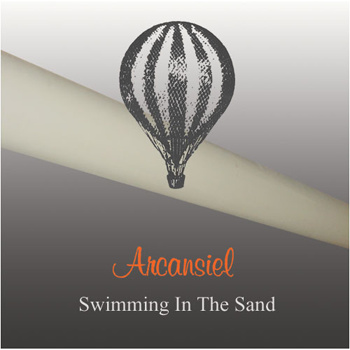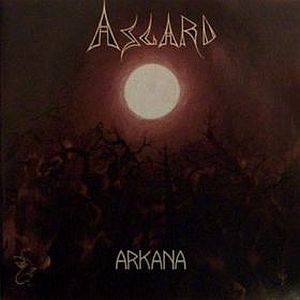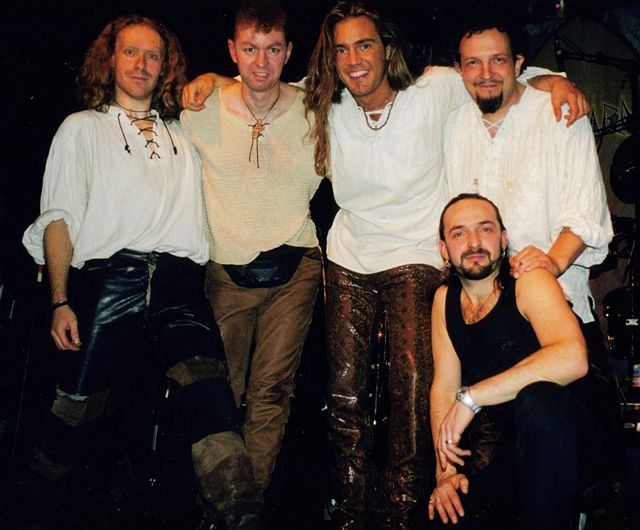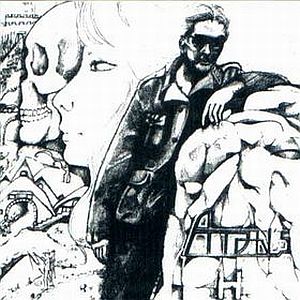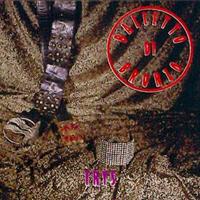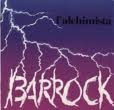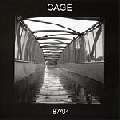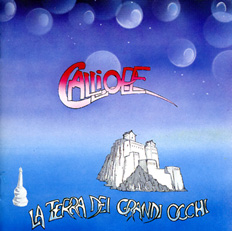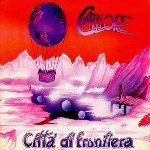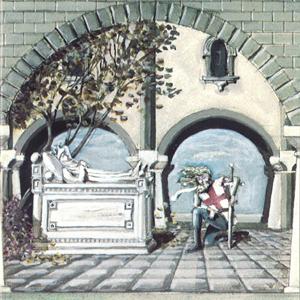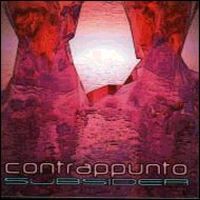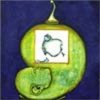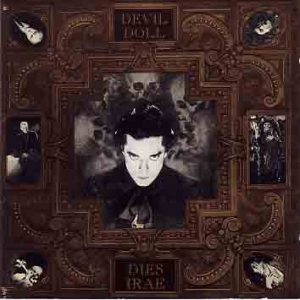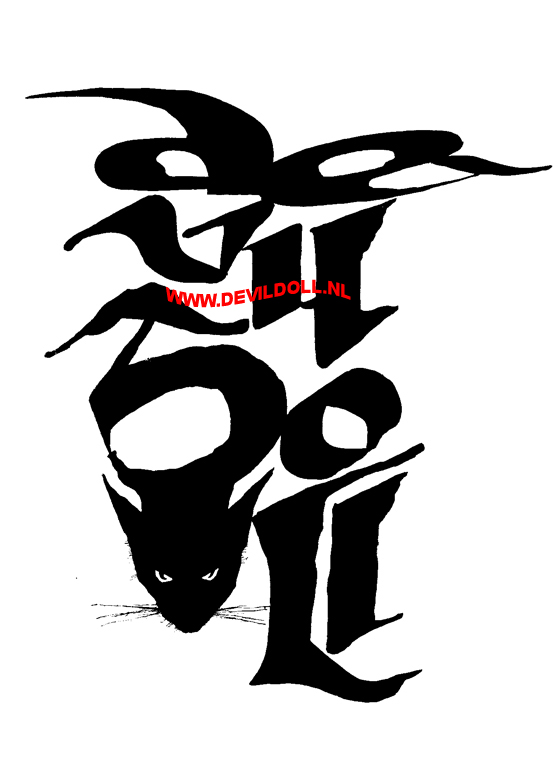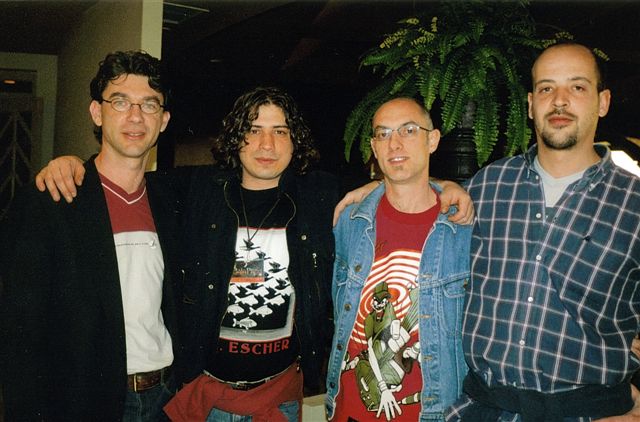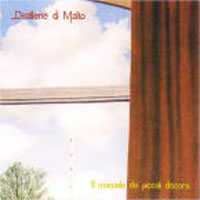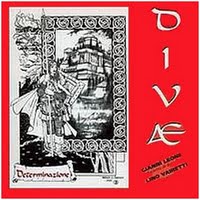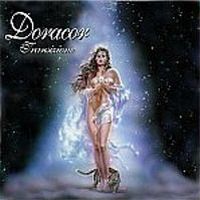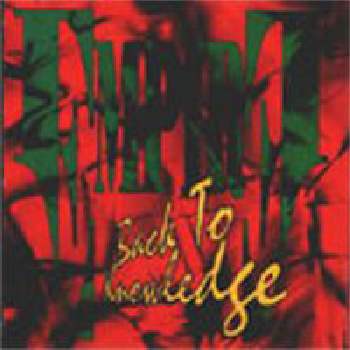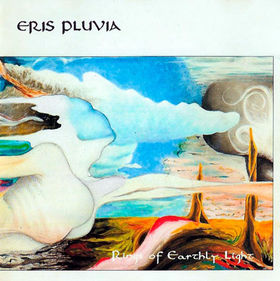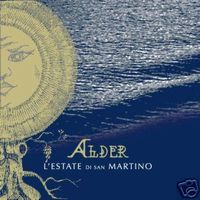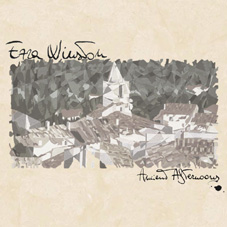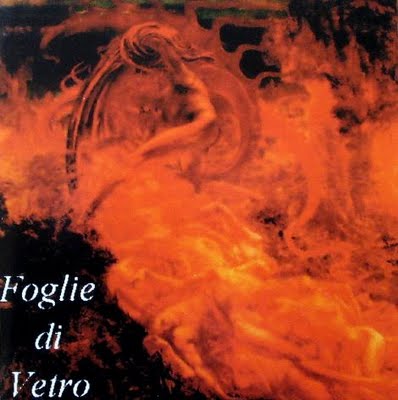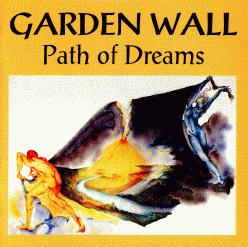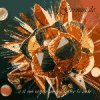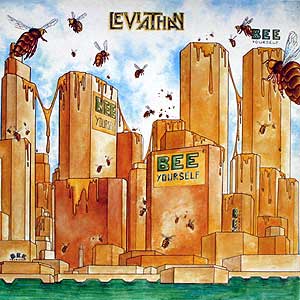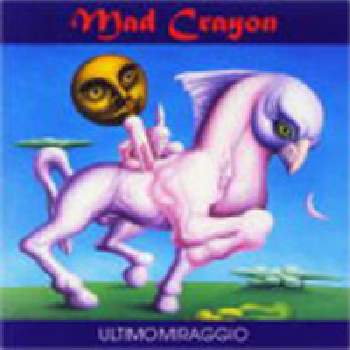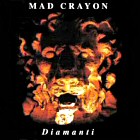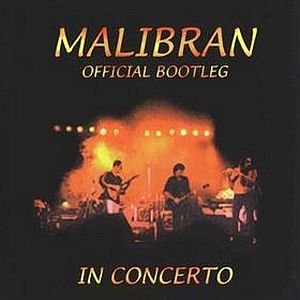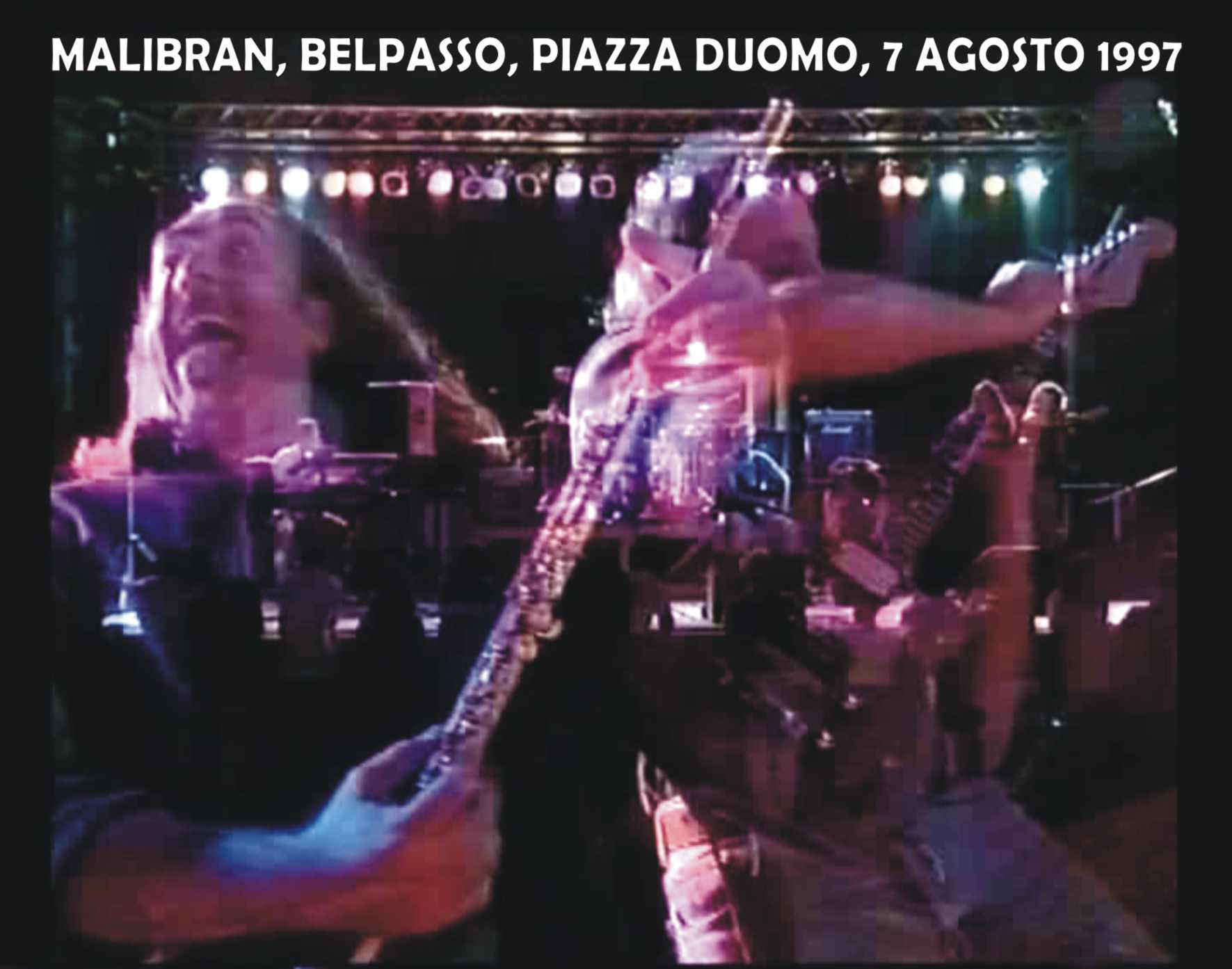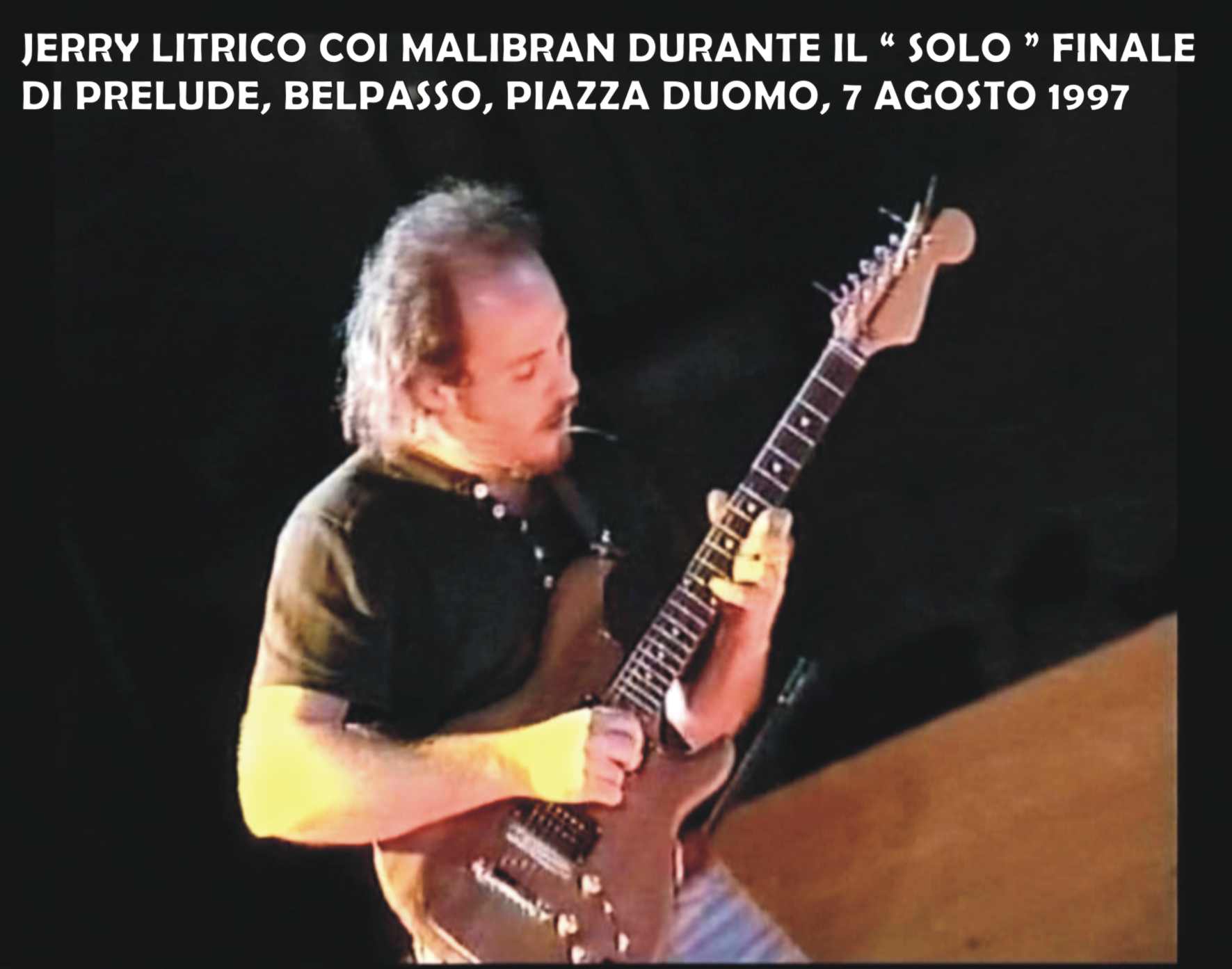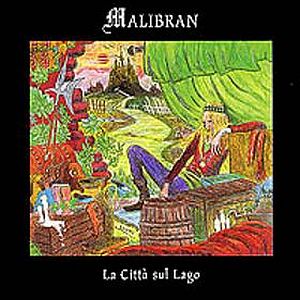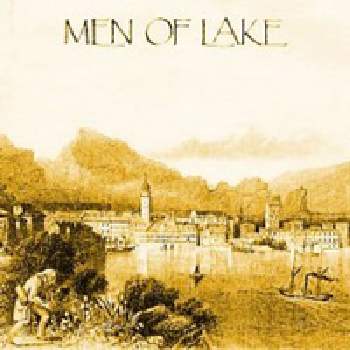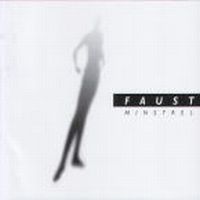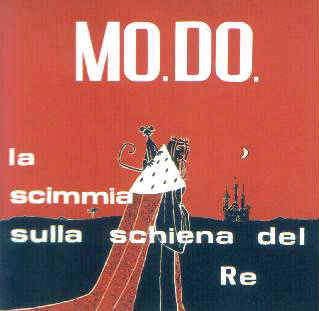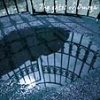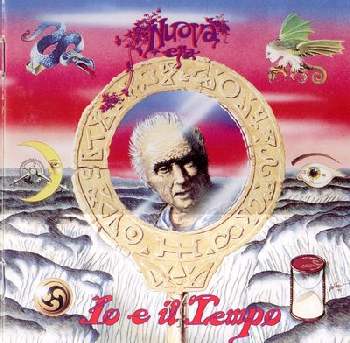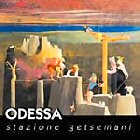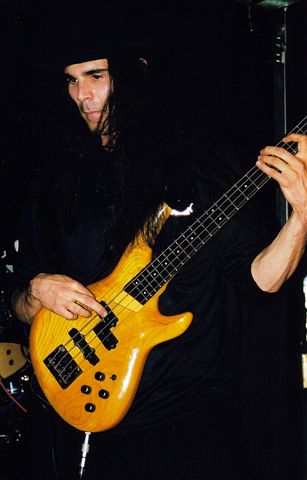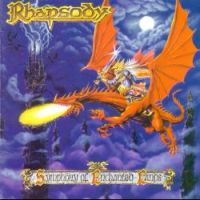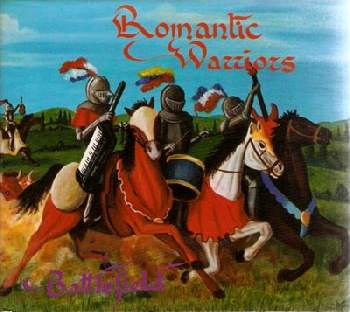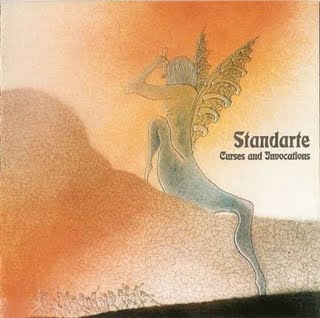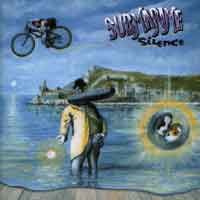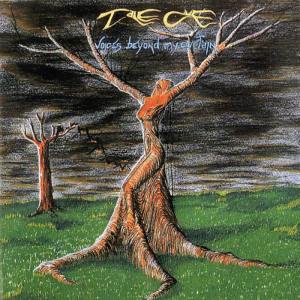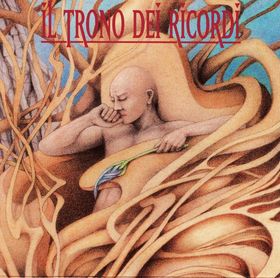ABIOGENESI - Abiogenesi (1995)
This eponymous debut album from
Abiogenesi
is still my favourite one. The horror-like paintings on the cover and the
mentioning of a quote by H.P. Lovecraft showcases a gothic sympathy, but I
don’t trace this very much on this album concerning the music. On the first
track
Ile St. Louis
(8:57) you will be pleased by the moving
atmosphere featuring a warm bass sound, pleasant organ waves and strong Italian
vocals. Halfway there is a wah-wah drenched guitar solo in the vein of
Mick Box from
Uriah Heep and in the end an acceleration guided by a compelling
Hammond organ solo and wah-wah guitar cries. Splendid! The second song
La Notte Di Ognissanti
(7:48)
starts with a mellow church organ-like
sound, then a slow rhythm delivering acoustic rhythm guitar, organ, sensitive
electric guitar including a howling solo, some harpsichord and strong vocals
with a fine emotional undertone. It strongly evokes seventies Italian prog
rock. What a wonderful atmosphere! The title track (9:20) features in the
mellow first part the romantic sound of the accordion, as if you were walking
on the banks of the river Seine in Paris. Then the atmosphere gradually becomes
a bit psychedelic, emphasized by a distorted (wah-wah), biting electric guitar
solo and powerful drumbeats. The final part again features the romantic
accordion sound.
L’Oscura Tenebra (9:52)
starts with military drumming, mellow organ and slow, sensitive electric guitar
runs, followed by a short mid-tempo culminating in a kind of ‘bluesy prog rock’
featuring strong, melancholic vocals, moving violin play and pleasant organ
waves. In the second part the rhythm changes to mid-tempo with a compelling
organ solo and a great build-up, sensitive electric guitar solo with howling
runs. Wonderful!
R.I.P. (2:30)
delivers nature sounds and wailing violin play. The final composition
Appurtamento La Luna (11:15) sounds
similar to early
Marillion, but it
fails to keep one’s attention. This is a rather disappointing end of a
beautiful, very warm sounding album.
ARCANSIEL - Swimming In The Sand: The Best Of
1989 - 2004
For me
Arcansiel
has always been a promising band that never reached the level of bands like
IQ,
Pendragon
or
Twelfth Night, although they had the
potential. Their three albums contained good compositions, but also weaker
material that couldn’t keep my attention. Now Arcansiel has delivered a ‘best
of ’ compilation and for the first time, how cynical, this fine band has made a
mature CD! An hour long you can enjoy alternating symphonic rock in the vein of
IQ with lots of breaks, changing of atmospheres and great solo work on guitar,
organ and saxophone with strong echoes from
Pink Floyd. Their ‘magnum opus’ is the long track
Evelyn (21 minutes) that starts mellow
with emotional vocals, than a catchy rhythm and many solos on violin, acoustic
– and electric guitar, organ and synthesizer and finally a compelling and
bombastic atmosphere with sensitive electric guitar play. If you like melodic,
24-carat symphonic rock with beautiful guitar and keyboards, this one is yours.
ASGARD – Arkana (1992)
The Italian/German formation
Asgard was
born in the northern part of Italy in 1987. One year later the band appeared on
the legendary Dutch double compilation album Exposure ’88, featuring many new
prog rock bands from Europe, and in 1991 Asgard released their debut album
entitled
Gotterdammerung. In The
Netherlands Asgard soon build-up a small but fanatic cult following: some fans
even had an Asgard tattoo and other fans knew the band members personally and
went to Italy to visit them at home! I also witnessed Asgard on a prog rock
festival in the early nineties. What a wonderful experience and what a warm
interaction between
the band and the euphoric fans!
In general, the third album Arkana, released in 1992 on the German Music Is Intelligence
label, is considered their most mature and balanced effort. It comprises
wonderful compositions with often early-
Genesis
and
Marillion inspired atmospheres
that range from mellow with flute, acoustic guitar and an instrumental
interlude with grand piano to bombastic with heavy guitars and powerful
keyboards, topped with emotional vocals and mythical lyrics by the charismatic
front man Kikko Grosso. The ‘slow-motion’ keyboard solo in the epic song
The Mirror Of The King is remarkable.
(Picture by Henri Strik)
ATON’S – H (1985)
This is the earliest effort by prog rock trio
Aton’s,
the album H is from 1985. The emphasis is on the atmosphere, rather than
excursions on guitar and keyboards. In general, the seventeen compositions
sound fluent and harmonic with many cheerful atmospheres featuring beautiful
acoustic guitar, twanging electric guitars with slight distortion and rather
functional keyboards. The warm and inspired vocals and some fiery electric guitar
soli are quite remarkable. The music on this fine album reminds me of fellow
Italian
Angelo Branduardi, mainly
because of the obvious folky elements. If you feel a little bit depressed,
stressed or unhappy, this album will help you to battle these feelings. In
dulci jubilo,
Mike Oldfield would say!
(IL) BALLETTO DI BRONZO – Trys (1999)
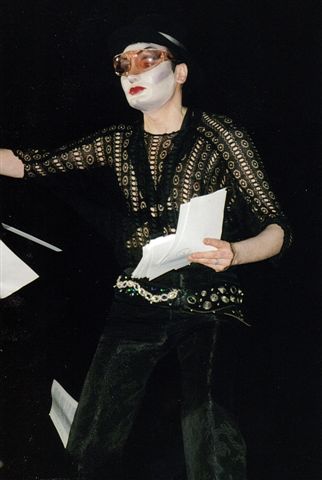
In 1996,
Il Balletto Di Bronzo
performed on a progressive rock festival in Rome, only singer/keyboardist
Gianni Leone
was from the original line-up. Compared to the music on their acclaimed album
Ys from
1972, the vintage keyboard sound disappeared. The eleven compositions sound
pleasant featuring some spectacular keyboard solos with hints from
Keith Emerson, but they don’t evoke the
intricate atmosphere from the early seventies. The song
Technoage
has even a house-like atmosphere delivering a tight and
propulsive beat along flashy synth runs! This is a decent keyboard-oriented
prog rock CD, but if you expect to hear more like
Ys,
it will probably become a disappointment.
(Picture by Henri Strik)
BARROCK – L’Alchimista (1990)
This band appeared on the legendary double album Exposure ’88 with
The Witch. Two years later
Barrock released their debut album
L’Alchimista.
The sound alternates between seventies symphonic rock, medieval and classical
music with hints from
Banco,
PFM and
ELP.
In the 13-minutes composition
Re Artu-Suite
and in the title track, evoking
Nuova Era,
you can enjoy the wonderful voices of female singers
Grazielle Vendramin and
Paolo Polese.
This is a fine album, but
most prog heads will be pleased more with the elaborate sounding successors
Oxian, in 1994 released on the Dutch
prog rock label SI Music, and
La Strega
released in 1999 on the Italian prog rock label Mellow Records.
CAGE – 87/94 (2003)
Cage
was founded in 1987. Soon they took part in
several shows, festivals and competitions in cities like Sienna, Rome and
Milan. In 1992, Cage got a contract from the label Toast in Torino and in the
same year, they released the single
View.
A year later Cage released their first album entitled
The Feebleminded Man.
In 1994, Cage appeared on the Italian TV with
a video clip, but later that year several members decided to work on their own
musical ideas. However, in 2000 they joined again and devoted themselves to a
new project that can be heard on the demo that Cage recorded in March 2001. In
2003, the band released
87/94
containing songs recorded between 1987 and 1994. Cage appeared on the satellite
channel Rock TV and is now working on further projects.
The six compositions on this compilation CD sound very melodic, pleasant and
alternating. The English vocals are decent, but no more than that. The strong
point is the tension between the mellow parts with classical piano and the
fierier and bombastic parts with harder-edged guitar work, tastefully layered
with duo-keyboard play with organ, piano, mellotron and synthesizers. Highlight
is the long track
The Feebleminded Man
(20.57) featuring many shifting moods, a strong and dynamic rhythm-section,
fiery electric guitar and many fluent synthesizer flights. The most captivating
moment is the final part: first tender piano and soft vocals, then ominous
guitar that gradually culminates in biting guitar sounds. The atmosphere turns
into very bombastic and finally there is an exciting duel between spectacular
guitar and flashy synthesizer. Cage is a very promising band!
CALLIOPE — La Terra Dei Grandi Occhi (1992)
The sound
from this Italian five piece delights me from the very first moment: dazzling
runs on the MiniMoog synthesizer, floods of Hammond organ, majestic mellotron
waves and warm vocals. The tracks
Non Ci Credo Piu,
Lunario and
Passi Dentro Il Tempo are fluent tracks
featuring powerful guitar- and keyboard play.
Avalon
and
L'Anima Del Cielo More
are mellower, delivering dreamy guitar and compelling organ and
mellotron waves, dynamic drums and emotional vocals. My personal highlight is
the long epic composition
Pensieri Affascinatti
with Banks-like organ play, a break with fiery electric guitar
and a lush grand finale, layered with vintage keyboards. A pleasant final song
is
Mellotronmania. This title speaks
for itself: many mellotron sounds, I love it! This is another strong effort
from an Italian band!
CALLIOPE – Citta Di Frontiera (1993)
I was very pleased with the debut album from
Calliope
loaded with vintage keyboards, so I had high expectations of this second album.
Well, some things changed and to my great sorrow, the mellotron and Hammond
sounds are less dominant. However, the compositions sound more elaborated and
the music from Calliope features more variation like in
Margherita a Rodi,
a wonderful ballad with beautiful piano play.
Senza Pretese is a short acoustic guitar piece.
Windsor has a spacey intro and
lots of saxophone.
L'Attesa sounds
folky with soaring keyboards. The unsurpassed mellotron is only omnipresent in
Terra Di Nessuno that also features a
Peter Bardens inspired organ solo.
Songs like
La Prova and the splendid
final composition
Il Ritorno delivers
many pleasant shifting moods and great work on guitar and keyboards. The strong
and enthusiastic vocals from
Massimo Berruti
(what a beautiful Italian names!) add an extra dimension to the
sound of Calliope. If you like melodic, fluent and symphonic rock, this one is
yours!
CIRCLE OF FAIRIES – As The Years Go By (1995)
Here’s another one-shot-band from Italy! The five piece
Circle Of Fairies
existed between 1992 and 1996. In 1993, the band
released a demo tape entitled
Twilight,
in 1995 followed by their debut album
As
The Years Go By that turned out to be their swansong.
Most of the
seven tasteful and melodic compositions between 7 and 12 minutes alternate
between seventies symphonic rock and neo-prog with a lot of variety, many
changing atmospheres and many solos. In
My Camouflage
and
Autumn Colours, we
can enjoy pleasant work on acoustic guitar, a strings sound and sensitive
vocals. In
On The Run, the admiration
of the seventies is obvious, due to the lush Hammond and mellotron sounds. The
two longest tracks are in the vein of
Marillion
: an intro with mellotron and electric guitar duet in
The Troubled Wake and a strong and moving guitar solo in the title
track. Although this music is beyond original and the recording quality is far
from optimal, I’m very pleased with this tribute to the masters of seventies
symphonic rock and neo-prog.
CONSORZIO ACQUA POTABILE - Nei Gorghy Del Tempo (1992)
Consorzio Acqua Potabile
(CAP) is an Italian sextet
featuring two keyboard- and two guitar players. Four out of the five tracks
have a running time over seven minutes and they sound interesting: lots of
shifting moods, breaks, soli on guitar and keyboards, a strong Italian voice
and a very decent level of compositional skills. It’s obvious that fellow
Italians
Banco are a source of
inspiration: the intro from the wonderful
Vivendo
contains great keyboards and beautiful acoustic guitar, the vocals are a
bit similar to Banco and CAP delivers a great, slightly changed version of the
Banco song
Traccia entitled
Traccia...Ora O E. This CD is a fine
discovery featuring pleasant Italian vocals.
CONTRAPPUNTO – Subidea (1999)
Here is an
Italian band on a Brazilian label reviewed by a Dutchman: music unites!
Contrappunto is from the city of Torino, known for their legendary football
club Juventus. The nine compositions on their first album (1999) contain a
fresh and modern sound with lots of captivating breaks. All musicians present
themselves in a very pleasant and crafted way: good female English vocals with
hints from Tracey Hitchings, a guitarist who plays very alternating: from
sensitive soli to heavy riffs, a keyboardist with a lush sound and flashy runs
and a tight rhythm-section. Some tracks evoke the
Phil Collins-era
Genesis
but in general, Contrappunto makes quite original prog that grows every turn.
The final song
Bad Choice is a funny one
with disco-like rhythm guitar and a jazzy piano. A promising debut album.
DEUS EX MACHINA – Cinque (2002)
Here is a
very interesting, very gifted sextet that was founded in 1985. Since their
debut album entitled
Galidum Caeli
from 1991, the band released six studio albums and two live albums (a CD in
1996 and an LP in 1997). Their latest effort
Imparis
(2008) also contains a DVD with live, TV and video
recordings between 1993 and 2006.
Deus Ex Machina
also performed on the annual USA Progfest in 1995. Although most
of their albums got a lot of praise,
Cinque
(2002) is their most acclaimed CD. The music is a unique blend of several
styles: from rock to avant-garde, but with the focus on jazz and fusion, with
hints from
Mahavishnu Orchestra,
Gentle Giant,
Frank Zappa,
ELP and
UK. You can enjoy complex arrangements
and exciting shifting moods, from mellow classical with acoustic guitar and
violin to bombastic with heavy guitar and majestic organ, embellished with
impressive vocals in the Latin language and a very dynamic and inventive
rhythm-section. The excitement on this album culminates in the 20-minutes final
epic composition Olim Sol Rogavit Terram II. Here you hear the band in its full
splendour. Who dare to say that progressive rock stopped being progressive
after the seventies should listen to this album!
DEVIL DOLL – Dies Irae (1995)
(review by Maurice Dam, Background Magazine #
53, June 1996)
Devil Doll
’s history goes back to 1987. A native of Venice, who calls himself
Mr. Doctor,
assembled a basic line-up to work on a project called
The Mark Of The Beast.
A second line-up formed in Ljubljana, the
capital of Slovenia in former Yugoslavia where Mr. Doctor caught attention of
producer
Juri Toni of
Laibach. With Toni,
The Mark Of The Beast was recorded at
the Tivoli Studios. Only a single copy of the album was made. Of course, this
can be considered as Devil Dolls rarest release to date. After this, the band
released three albums and apart from these albums, Mr. Doctor did a tribute
performance to German composer Hans Eisler in 1989. A CD of this performance is
available under the title
Mr. Doctor
Sings Hans Eisler.
Several Devil Doll releases followed, most of these
so-called fan club issues have additional intros and outros. American label
Renaissance released all Devil Doll albums on CD with alternative artwork.
The Sacrilege Of Fatal Arms (1993) is
the most striking and features several parts from cult horror movies. This
album is the soundtrack version of a frightening video performance of Sacrilegium,
extending the piece over seventy minutes.
In 1995, Devil Doll released a new album entitled
Dies
Irae.
It will be no surprise that Mr. Doctor took the theatrical aspects a
bit further than on Sacrilegium. This does not only concern the music! During
the recordings, a fire destroyed the studio completely including all the
recordings.
Dies Irae is a classical,
conceptual work in sixteen acts in the true theatrical Victorian hammer horror
imagery. All ingredients are present. The piano is the most important
instrument to accompany Mr. Doctor’s dramatic, excruciating and painful voice
in
Peter Hammil-style. However,
Dies Irae also contains a number of
pieces of classical pieces varying from only violin or organ to a complete
symphony orchestra. If you listen to this album a few times, it is easy to
imagine the scenes Edgar Allan Poe has put to words so well. The balance
between classical and heavy parts, gives the music an extra dimension. There
are several brilliant guitar solos. This album really gives you the chills and
it builds up to a grand finale. The music cries out for a stage performance
with orchestra and choir. For all disbelievers: I hope I have convinced you to
explore the wonderful world of Devil Doll.
D.F.A. – Works In Progress Live (2001)
This live
album is a registration of the concert at the annual Nearfest festival in the
USA, June 17th, 2000. From the very first moment,
D.F.A. impressed me. The music has been built around varied
keyboards like Hammond, Fender Rhodes electric piano, several synthesizer
sounds and fiery electric guitar with captivating interplay, strong soli and a
tight and powerful rhythm-section. Every song has its own dynamic and
variety.
Escher has an
Ozric Tentacles-atmosphere, but less exotic. We hear splendid
keyboards in the jazzy-inspired
Caleidoscopio
with
some echoes of
Gentle Giant, moving electric guitar
and flashy synths in
Trip On The Metro,
strong jazz-rock in the long and very alternating
La Via, great soli and organ/guitar interplay, compelling build-up
parts and again splendid keyboards in
Pantera
and tasteful jazz-rock in the swinging
Ragno.
This review is rather euphoric, but in my opinion, this is one of the best new
Italian jazz rock releases.
(Picture by Henri Strik)
DISTILLERIE DI MALTO- Manuale Del Piccoli
Discorsi (2001)
Distillerie Di Malto
is a five-piece band that includes
two guitar players and a keyboardist, on the last track supplemented by a flute
player. This debut album is dedicated to René Magritte, one of my favourite
surrealistic painters. On the first track
Allegro
Con Brio
the atmosphere is ominous and ambient following by a fluent rhythm
featuring organ and guitar. Enjoy the dynamic music with fiery electric guitar
and wonderful keyboard play.
Phoebus
starts a bit experimental with a xylophone, repetitive bass and electric guitar
with hints from early
King Crimson.
Then the mood shifts from up-tempo with mellow organ, fiery electric guitar and
flute to dreamy with classical guitar and flute and atmospheric with flute,
hi-hats and piano. Very alternating.
Melodia Di Fine
Autunno starts with a
compelling atmosphere that gradually grows to bombastic, interfered by mellow
pieces until a long and sumptuous finale, featuring lush keyboards,
harder-edged guitar and a dynamic rhythm-section. The next composition is the
longest one entitled
Aria E Vento
again a very alternating track: twanging guitars and great keyboards like
sparkling piano, moving with a wonderful guitar solo in the vein of
Hackett/Latimer, bombastic with organ
and even an interlude with classical guitar and flute. The music often evokes
early
Genesis, wonderful! The final song
5/5/1555 starts with xylophone,
like the second track, and electric guitar, followed by some sensational,
mid-Emerson inspired synthesizer soli and lots of varied atmospheres featuring
strong Italian vocals, howling electric guitar and dreamy flute. The ‘grand
finale’ delivers a moving atmosphere with a splendid build-up guitar solo,
supported by lush keyboards. Prog heaven! This CD has hints from Genesis,
Camel and King Crimson for the more
complex and experimental parts and contains five elaborate and tastefully
coloured compositions. What a strong debut album!
DIVAE – Determinazione (1995)
Divae
’s first serious gig was as a support act for Italian prog rock legend
Le Orme in
Rome’s Palladium, 1994. The band started to write compositions and end 1995
Divae performed on several festivals: The Marechiaro Blues Festival (alongside
Banco,
The Jack Bruce Band and
Jefferson Starship)
, the Palladium in Rome (during a medley with
Gentle Giant-songs, guitarist
Gary Green
joined Divae on stage) and The Music Of Freedom Festival (with
Finisterre and the known
Il Balletto Di Bronzo). On their debut
album
Detreminazone Il Balletto Di
Bronzo keyboardist
Gianni Leone and
Osanna’s
Lino Vairetti contribute on the song
Vento Che Va. Divae has two keyboard players; the drummer also
plays keyboards so it’s no surprise that their music is often keyboard-driven
with echoes from Banco (Hammond organ) and
PFM
(flashy synthesizer flights). The music also evokes Gentle Giant and
Camel. Strong points are the interplay
between the guitarist and the keyboard player, the passionate vocals with
theatrical undertones and the captivating shifting moods. Their sound is fresh
and dynamic, unfortunately Divae turned out to be another promising Italian
one-shot band.
DORACOR – Transizione (2001)
I was very pleased with the latest release by
Doracor
entitled
Evanescenze. What a
wonderful symphonic rock album! This album, however, is from 2001 and contains
three long tracks. The first
Cavaliere Del Destino
(26.43) manages to keep my attention despite the long running
time. You can hear many pleasant musical ideas and fluent shifting moods from
mellow, with beautiful violin and piano to bombastic with flashy synthesizer
runs and heavy guitar riffs or mid-tempo with strong vocals and fiery guitar.
Remarkable is the middle section featuring
The Enid
-like prog delivering classical orchestrations and flowing, sensitive
electric guitar work. The second song
Luce Ed Ombra
(7.12) contains a fluent rhythm with mellotron choir samples.
Halfway the atmosphere turns into dreamy with a wonderful violin, piano and
flute. The final part features a fiery and heavy guitar solo! The third
composition
Transizione (17.44)
sounds very alternating and tasteful with great keyboards: sensational
synthesizer runs and impressive church organ samples. Again, the guitar is
harder-edged and forms a good counterpart to the keyboards. Doracor doesn’t
make very original prog, but their sound delights me, this is beautiful
symphonic rock!
EMPIRE – BACK TO KNOWLEDGE (1994)
Empire
is an Italian one-shot band that featured the duo formation
Syndone (drummer
Paolo Sburlati and keyboardist
Edo Rogani) and female singer
Rosanna De Luca.
Most of the nine compositions sound fluent and modern with varied
keyboards that contain obvious hints from
Eddie
Jobson and
Keith Emerson. The
vocals remind me of
Annie Lennox. In
the track
Immortal we can enjoy a
guest on guitar and the composition
The Nite
is based upon the famous classical piece
Night On Bald Mountain by Modest Mussorgsky in which the drums
sound very powerful and the keyboard play is a tribute to Emerson/Jobson.
Despite the poppy overtones in the songs with vocals, this CD is a pleasant
effort for keyboard freaks.
ERIS PLUVIA – Rings Of Earthly Light (1991)
Eris Pluvia was founded in 1988,
two years later this often overlooked formation released the demo tape
Pushing Together and in 1991 the album
Rings Of Earthly Light. The music sounds
varied, but a bit laid-back: between
Camel
and
Pink Floyd with some jazzy
sidesteps in the title track.
The Rising Mist
is a ballad with wonderful guitar, pleasant jazz-rock in
The Broken Path, ambient in
Glares Of Mind, beautiful vocals and
piano in
Pushing Together and a
tasteful colouring with flute, saxophone and guitar in the subdued final song
The Way Home. All songs sound very
melodic and harmonic with a strong romantic undertone, a kind of ‘pastoral
prog’ with the focus on creating pleasant atmospheres rather than showing skills.
(L’) ESTATE DI SAN MARTINO – Alder (CD 2006)
L’Estate Di San Martino
was founded in 1975. In the early
eighties, they started to work out a concept story about an angler who makes an
imaginary journey to knowledge. In 1983, the band made recordings during two
nights, but it took 23 years before the prolific Italian prog rock label Btf.
released it on CD issued in a beautiful mini gatefold package. The ten
compositions on the album
Alder sound
quite mellow with lots of twanging acoustic guitars and some flute. It reminds
me of the folky side of early
Genesis.
The keyboards are a bit on the background featuring some synthesizer flights
and grand piano. At those moments I like Alder’s in general 'pastoral prog',
embellished with beautiful Italian vocals and some moving electric guitar work.
A nice album, no more no less in my opinion. It will please the more romantic
prog heads.
P.S.: In 2007, the band released the well-received new album
Febo.
EZRA WINSTON – Ancient Afternoon (1990)
Ancient Afternoon
is a beauty from the nineties by
Ezra Winston,
two years after their acclaimed debut album
Myth Of The Crysavides. The first track
The
Painter And The King
consists of five parts and has a delicate classical
inspired symphonic sound with flute and acoustic guitar and strong hints from
early
Genesis. The electric guitar
play is very flowing and sensitive. The next song
Verge Of Suicide (four parts) has echoes from
PFM,
due to the sparkling flute and the acoustic guitar and warm
vocals. The final part includes fanfare-like bombastic keyboards and drums.
Then a shorter song entitled
Night Storm
with a compelling, symphonic atmosphere featuring howling electric guitar,
accompanied by saxophone and flute. The fourth composition
Ancient Afternoon Of An Unknown Town
is with nine parts and 26
minutes the 'magnum opus' of the album. It sounds very alternating: from mellow
with acoustic guitars, flute and floating keyboards to bombastic with swirling
flute. We also hear up-tempo rhythms with sumptuous synthesizers in the vein of
the Japanese prog (
Gerard,
Déjà Vu,
Ars Nova)
. Surprising elements are the use of xylophone, brass and
classical guitar. The final song
Shades Of Grey
is a short bonus track that delivers twanging acoustic guitar, flute and
Steve Hackett-like guitar,
strongly evoking early Genesis. If you like early Genesis and classical music,
this CD is worth a try.
FOGLIE DI VETRO – Same (1996)
During my
work for Dutch prog rock magazine iO Pages, I reviewed many new Italian prog
rock bands. Despite the language gap, they kept on sending floods of promo
CD’s, especially between 1995 and 2000. Here’s a very fine one from 1996.
Listening to this eponymous debut album,
I’m delighted about the tension between the mellow parts and the powerful
parts, the inventive twists and turns, the tasteful interplay and the blend of
instruments. Let’s not forget about the keyboards, the Italian trademark. We
hear beautiful piano work from tender to sparkling, a lush strings-sound and
bombastic synthesizer layers. My highlight is the long and varied title track
in which the band plays at their peak and you can enjoy
Foglie Di Vetro
’s trademark: the wonderful, often compelling
interplay between piano and electric guitar: from sensitive solos to propulsive
riffs, embellished with a saxophone solo and emotional vocals and culminating
in a strong bombastic final part. What a beautiful album! Unfortunately, Foglie
Di Vetro turned out to be another fine Italian one-shot-band.
GARDEN WALL – Path Of Dreams (1994)
(review by Maurice Dam, Background Magazine #
45, February 1995)
After a good entry into the progressive scene,
Garden
Wall
are ready to show if they are to stay there. This time we are taken on a
Path Of Dreams, starting off at
Prelude, The Gates Of Hypnos an
instrumental piano piece that paves the way for a dream of love
Communion. The main theme of the CD is
the human path from birth to death, the dreams one has and the disillusions
that follow.
The sound
of Garden Wall hasn’t changed very much since the previous album. They still
show a distinct influence of IQ in a darker sense, this time slightly mingled
with a Dream Theater-like style. The band definitely developed a certain style
of their own though, sometimes with floating guitar leads that cut through the
dark and gloomy paths of the keyboards. Vocalist, guitarist and keyboardist
Alessandro Seravalle has a dark
opera-like voice that suits the music splendidly. He even screams out the
lyrics at times.
The next dream is the dream of purity,
The Bride
Of The Wind, the second instrumental piece on this CD followed by
Sex, The Dream Of Life. In two parts, we
can enjoy ourselves: first in the
Hotness
Of The Flesh, followed by
Soft Warm,
the instrumental segment that is not everyday-good-clean-happy-prog, but having
one of the best guitar solos on this disc. After pleasure, pain immediately
follows with another piano piece,
Interlude:
Between Eros And Thanatos leading us to the dream of neurosis and
Band Luft, another instrumental that
comes close to
On De Radio from their
previous album.
Kaos, The Dream Of Hate
and
Onirios,
The Dream Of Awe are two of the heavier pieces on this album. At
first I didn’t get beyond this point as it was just too much to swallow in one
go. Luckily, the next track gets more progressive.
The Cage, The Dream Of Pain has a beautiful intro in the vein of
Genesis in the early seventies. There’s
even a mellotron to be heard for the hobbits among us. Our journey ends at the
dream of death,
May Di Muart with
lyrics sung in Latin: “Here all is lost, all is past, all is nothing.” The sad
piano piece
Mortal Maj closes the
album and our journey is over. The booklet gives the English translation of
Maj Di Muart.
If you are
extremely depressed then this is not the CD you want to play, unless you want
to make your final journey. For the more serious prog rock fans among us, this
isn’t an album will easily get into you as it definitely needs several spins.
However, once you are through, it will be a treat.
GERMINALE — E Il Suo Respiro Ancora Agitata Le
Onde (1995)
This second album from
Germinale
is their best. What a wonderful and lush 24-carat symphonic rock sound!
Il Gia Sentito E Il Non Ancora (1:35)
: the first track features a mellow
atmosphere with twanging guitar and dreamy vocals.
Maggio (9:29):
a pleasant and varied up-tempo song, nicely
coloured with flute, organ and electric guitar.
D'Ombra, Vapori E Sabbia (6:41):
a fluent rhythm with a wonderful
harmony between mellotron, organ and flute and fine solos on guitar and flute.
This composition contains many good musical ideas.
Eleonora (4:20):
a dreamy piece with twanging electric guitar.
Le Onde, Respiro Del Mare (8:46):
a very good composition delivering
a compelling atmosphere and spectacular keyboard playing. The moods shift from
mellow to up-tempo with bombastic Hammond organ and fiery electric guitar, the
interplay between these instruments also sound great!
Dioniso Inquieto (4:22):
beautiful twelve-string acoustic
guitar, a sound that I love since early Genesis! The piano supports a subdued,
very sensitive electric guitar solo.
Malcreanza (6:59):
lots of excitement here: a break with a flute
solo, Fripperian guitar work, a Moog-synthesizer solo on the Prodigy, the poor
man's Moog..!, and many changing atmospheres.
D'io (3:40):
this short and romantic piece features vocals,
twanging guitar and wonderful mellotron waves.
Avant - Grado (9:20):
another great composition that
starts with beautiful flute and sparkling classical piano, then an up-tempo
piece with bombastic organ.
In Aeternum Veritas (0:58):
only a voice and twanging acoustic guitar.
Meurglys III (The Songwriters Guild) (7:42):
a
Van Der Graaf Generator
-cover featuring an intro with soft
mellotron and flute, then emotional vocals and fiery Fripperian guitar,
changing atmospheres and a wonderful final part with organ and piano.
LEVIATHAN – Bee Yourself (1990)
After their promising debut album entitled
Heartquake
(1988),
Leviathan
(founded in 1985) was embraced by the neo-prog heads, although the music also
contains elements of
Genesis and
classic Italian prog legends
PFM and
Banco. The neo-prog heads were even
more pleased with the successor
Bee Yourself .
A huge boost to Leviathan’s sound was the new, classically
trained keyboardist
Andrea Amici,
especially in the epic title track, we can enjoy his lush keyboard work. The
album sold very well, but Leviathan disappeared for seven years until they
released the album
Volume in 1997 and
recently Leviathan collaborated with new compositions to the musical projects
Kalevala (2003),
The Colossus Of Rhodes (2004) and
Giallo!
(2009) and the band is working on the English version of
their active website. Here are some comments on the contribution to the
Giallo!-project:
Vecchi Giochi (21.03, four parts):
we can enjoy 24-carat symphonic
rock and vintage keyboards like the MiniMoog, Hammond and mellotron. It starts
of with beautiful grand piano, classical orchestrations and inspired Italian
vocals, the music alternates between dreamy, mid-tempo rhythms and bombastic
featuring sparkling piano and fluent Hammond runs. Due to the heavy Taurus
bass-pedals and the
Steve Hackett-like
guitar, Leviathan evokes
Wind And Wuthering
-era Genesis, what a wonderful music! The final part is great
delivering a slow rhythm with bass pedals, synthesizer flights and mellotron
choirs, topped with passionate Italian vocals. Goose bumps!
MAD CRAYON – Ultimo Miraggio (1994)
Mad Crayon
has been rooted twice in the past. First, the
album cover that has been designed by Mac Mazzierri, who once created the cover
of
Le Orme’s album
Uomo Di Pezza. Second, their sound that
has obvious hints from mid-era
Genesis:
tasteful and melodic symphonic rock delivering wonderful interplay between the
guitar and dual keyboards strongly evoking
Steve
Hackett and
Tony Banks.
The song
Running Child
contains pieces derived
from the famous classical composer J.S. Bach. To my surprise, the vocals are
not only in Italian, but also in English. That is a pity because Italian should
sing in their beautiful native language. The English vocals lack a bit power
and emotion. That’s my only negative remark. Enjoy this wonderful prog rock
album.
MAD CRAYON – Diamanti (1999)
Diamanti is the successor of
Ultimo Miraggio,
released in 1999 so we had to wait five years! On this album,
Mad Crayon sounds tight,
fluent and convincing. Their compositions are tasteful featuring lots of
pleasant changing atmospheres. The band has two keyboard players and three
guitarists, which culminate in many solos. The best moments are in
Deserti: a dreamy first part, then a
saxophone solo, sparkling piano, a moving guitar solo and great interplay
between violin and piano.
Glorioso Destino
has many fine musical ideas and strong soli. Mad Crayon’s prog rock
doesn’t sound original or complex, but they deliver very melodic, harmonic and
pleasant music.
MALIBRAN – In Concerto (1997)
These live recordings are from 1997 when
Malibran
performed
on the famous island of Sicily. The sound of this recording has the quality
level of a decent bootleg, but to me that is no problem at all. There is plenty
to enjoy on this live album. Ten pleasant and melodic compositions featuring
great dual guitar play with hints from
Steve Rothery
and
David Gilmour and
swirling work on the flute. Only the
keyboards sound a bit too functional. Highlights are an abridged version of
Pyramid’s Street with a Bolero-rhythm
and an Arabian atmosphere,
Magica Attesa
with good soli on guitar and flute and the long, captivating
Prelude evoking early
Marillion delivering a fiery and powerful,
Ritchie Blackmore-inspired
solo. Malibran will never be rewarded as a very original or extremely crafty
prog rock band, but to me they sound pleasant and varied. Many parts of this
live album can also be heard and seen on their DVD
Malibran 10 Anni In Concerto. I hope to see Malibran live on stage
once!
MALIBRAN – La Citta Sul Lago (1998)
One year later
Malibran
released their fourth
album entitled La Citta Sul Lago. Despite the long running time (about 70
minutes), Malibran succeeds in keeping my attention. The compositions sound
alternating featuring many strong shifting moods, breaks and soli and a varied
instrumentation with guitars, flute, saxophone and piano). My highlights are a
fiery, wah-wah drenched guitar solo in the title track, a playful percussive
break with a biting guitar solo in
The Time,
a
Jethro Tull-inspired part in
La Stagione Del Re and metal
guitar and protrusive drums in
Nuvole Di Vetro.
If I compare this album to their previous work like
Le Porte Del Silenzio, the
Marillion
-echoes are almost faded away. I trace some elements from
Camel (mostly flute and guitars),
Genesis
(keyboards and twelve-string guitars) and
Jethro Tull
(flute), but gradually Malibran has managed to sound rather original.
A special remark is for the splendid guitar work from
Guiseppe Scaravelli and
Jerry Litrico in the vein of
Steve Rothery (Marillion) and
Andy Latimer (Camel).
They deliver many moving and exciting solos and dual guitar play!
MEN OF LAKE - Men of Lake (1991)
Men Of Lake
released four studio-albums between 1991 and
1998. However, this eponymous debut album is still my favourite one. The
structure of the eight compositions is simple, but very tastefully. You will be
carried away by the warm atmosphere, featuring a lush Hammond and Farfisa organ
sound and pleasant vocals. The guitar play is subdued, but fits perfect to the
often romantic and melancholic atmospheres. Some songs are mellow, other
contain bombastic eruptions delivering majestic floods of organ. If you like
the melodic organ-driven prog rock in the vein of
Procol Harum and
Rare Bird,
this album is a delight.
MINSTREL - Faust (2000)
This
overlooked band started in 1991, but it took six years before Minstrel released
a demo tape entitled
New Life, in 2000
followed by their debut album
Faust.
By the way, I read about plans for a new CD entitled
Moby Dick on their website, but the latest update is from 2006, so
let’s concentrate on this wonderful album Faust.
Preludio (Una Selva Una Storia) (1:20):
this short one contains spoken words in the Italian language.
Atto I, Scena I: Bellatrix (5:28):
the track starts with twanging
acoustic guitar, typical dramatic Italian vocals and wonderful keyboards. In
the end a splendid ‘finishing touch’ featuring a fiery and very compelling
electric guitar solo.
Atto I, Scena II: Mefistofele (8:55):
this track delivers an exciting
tension between the acoustic piano and protrusive electric guitar. Also very
moving is the acoustic guitar/piano interplay and a moving guitar solo,
supported by a beautiful string sound. The final part is bombastic, in the
great Italian prog rock tradition!
Atto I, Scena III: Il Castello (6:52):
up-tempo with fiery guitar, then a
mellow part with piano, moving electric guitar and floating keyboards. The
vocals are great and the grand finale carries you away to a prog Walhalla!
Atto II, Scena I: Faust (9:49):
the intro features bombastic keyboards, then a mid-tempo with echoes from mid-
Genesis.
Remarkable is the wah-wah drenched guitar solo.
Atto II, Scena II: La Neve (7:52):
first twanging guitars, dreamy
vocals and mellow keyboards, then a compelling bombastic atmosphere delivering
a wonderful electric guitar solo.
Finale (Ogni Viaggio) (4:17):
this one only features piano and spoken words.
My conclusion: another overlooked Italian gem!
MO.DO - La Scimmia Sulla Schiena Del Re (1980)
Talking about overlooked gems, here is the five-piece formation
MO.DO
founded in the late seventies - 1978 to be precise - by
Walter Locatelli, who was the drummer
of the well-known prog rock band
Dalton.
MO.DO turned out to be a one-shot band. Their album
La Scimmia Sulla Schiena Del Re was released in 1980 and re-issued
on CD in 1993 by Mellow Records. To me the music sounds as a blend of typical
melodic classic Italian prog rock bands in the vein of
PFM and
Banco
and more complex oriented prog rock like
Gentle Giant.
The eight compositions deliver lots of instrumental parts with good
work on guitar, vintage keyboards like the Solina string-ensemble and
Moog-synthesizers and flute along pleasant harmonies.
La Scimmia... is a nice album to discover
after you checked out the familiar bands.
MOONGARDEN -The Gates Of Omega (2001)
In 2006, I
witnessed a concert by this amazing prog rock band. I was impressed by the performance
of the singer, the wonderful keyboard sound and the varied compositions.
The Gates Of Omega is not an easy album
to listen to. The atmospheres frequently change from romantic, a bit
melancholic progressive pop like nineties
U2
and
Peter Gabriel to pure symphonic
rock like mid-
Genesis with
lush keyboards, Moog Taurus bass
pedals, twanging guitars, sensitive, flowing guitar soli and even electronic
music in the vein of
Tangerine Dream
74-80 era. However,
Moongarden also
delivered fine musical ideas like mellotron choir waves blended with Spanish
guitar, a beautiful piece on acoustic piano and a song featuring a sultry,
exotic atmosphere with a djembe percussion sound, flowing keyboards and the
distinctive bass stick. My highlights are the compelling, often long soli on
the electric guitar and the omnipresent mellotron waves of choir, flute and
violin sounds. This double album sounds as prog rock to discover. Moongarden
delivered a wonderful piece of music with emotions, skills and variety. This is
good prog rock music, worth to check out!
NUOVA ERA — Io E Il Tempo (1992)
This is the third album from the fine
Nuova Era.
Their debut album
L’Ultimo Viaggio
sounded promising, but a bit precarious. On the contrary, their second album
Dopo L’Infinito sounded strong, but very
ELP inspired. My first session with
Io E Il Tempo evoked good feelings, I
quickly concluded that Nuova Era had delivered their best work. What a pleasant
atmospheres and what a beautiful compositions! The album contains two long,
very tasteful and alternating, tracks from dreamy to powerful and bombastic.
The sound of the guitar and the keyboards is wonderful, the duels are
magnificent and we can enjoy many strong guitar and keyboard solos. The vocals
are distinctive, but in the background. In general, Nuova Era makes
instrumental music. This is a CD to discover.
ODESSA – Stazione Getsemani (1999)
This overlooked four-piece was founded in the late nineties. Their album
Stazione Getsemani sounds varied with
excellent work on guitar and keyboards, lots of breaks and shifting moods. You
have to be up to the strong and expressive, but sometimes pretty raw or
theatrical vocals. The atmosphere changes from dreamy with tender grand piano
and warm vocals in
Di Buio E Luce or
slow rhythms with howling electric guitar in
Esilio.
In
Di Buio E Luce and
Lotta Per Il Dominio we hear
mid-tempos with a dynamic rhythm section, swirling flute and fiery electric
guitar, bombastic with powerful Hammond and fat synthesizers, especially
Alzo Un Muro Elettrico and even some
experimental sounds like in
La Sfera.
The heavy work on guitar and Hammond reminds me of seventies
Deep Purple, very exciting and compelling.
Stazione Getsemani is a captivating album.
(Picture by Henri Strik)
RHAPSODY (OF FIRE) - Symphony Of Enchanted
Lands (1998)
The favourites of guitarist
Luca Turilli
and keyboard player
Alex Staropoli of
Rhapsody (Of Fire) are Bach, Paganini and
Yngwie Malmsteen. However, it is
no surprise that the music of Rhapsody is a blend of classical music and prog
metal. After the acclaimed demo tape
Land
Of Immortals the band released their debut album
Legendary Tales in 1997 followed by
Symphony Of Enchanted Lands.
On this album, Rhapsody has invited a
Russian choir and use instruments like hobo, lute, violin, harpsichord,
acoustic guitars, mandolin and the ethnic Russian balalaika. The result is a
dynamic and varied mix of classical music, symphonic rock and heavy metal,
which sometimes is very impressive and exciting! My first highlight is
Eternal Glory, a prog metal song along
mellow parts with flute and harpsichord. Next the compelling ballad
Wings Of Destiny with great tension
between keyboards and vocals.
Riding The
Winds Of Destiny
with sparkling, often orchestral keyboards, violin and
fiery speed metal interludes. My absolute favourite track is
The Dark Tower Of Abyss.
To me this composition sounds like Vivaldi meets Savatage
featuring a swirling violin-section, biting guitar and powerful drums.
Personally, I don't like heavy and prog metal. Thus, in general I have problems
with listening to those albums. Nevertheless, Rhapsody generates a lot of
excitement to me, because they succeeded in finding a perfect balance between
classical music, symphonic rock and metal.
ROMANTIC WARRIORS – Battlefield (1992)
In the
nineties, the Italian prog rock label Vinyl Magic founded a project named New
Progressive ’90 in order to release albums by new Italian prog rock bands like
Calliope,
Syndone
and
Il Castello Di Atlante.
The producer was Italian keyboard player
Beppe Crovella, a former member of classic Italian prog legend
Arti & Mesteri. He decided to
establish his own band named
Romantic Warriors
and make an album entitled
Battlefield
for that project. This album contains many swinging rhythms and most songs
deliver Emersonian keyboard work, with both vintage and modern sounds like in
Open The Gates: early
ELP meets new
Genesis. In
The
Dreambreaker, we can also enjoy raw
guitar work with a heavy organ wall in a slow rhythm and a wonderful
organ-guitar duet in
Song To John.
I’m also pleased with the melancholic accordion sound in
Montmartre
although the vocals lack the emotions that make you
dream about Paris. If you like modern and accessible keyboard-driven prog rock,
this CD is worth to check out.
STANDARTE - Curses And Invocations (1996)
This keyboard-driven
prog rock trio does a very fine job by reviving the wonderful seventies sound
loaded with the ‘Mighty Three’: mellotron, Hammond organ and Moog-synthesizer.
What a ‘vintage heaven’! Those keyboards alongside piano and harpsichord, gives
this second album from Standarte a pleasant atmosphere by. On every track you
will hear floods of Hammond, Moog and mellotron. Don’t expect elaborated,
refined or subtle music: all songs haven been very simply structured and the
vocals have a limited range. As a tribute to the early British progressive
movement known for its lush keyboard sound, Standarte plays the first part of
the song
Super Nova from
Gracious. This is another great
surprise from the small Italian Black Widow label.
SUBMARINE SILENCE – Submarine Silence (2001)
Paul
Whitehead created the cover art for this album. He was responsible for some
stunning cover paintings on the early
Genesis
albums
Nursery Cryme and
Foxtrot as well. So that is one link to
Genesis; the music is the other one: beautiful twanging acoustic guitars,
Steve Hackett and
Andy Latimer inspired electric guitar and keyboards with strong
echoes from
Tony Banks with lots of
mellotron flutes, violins and choir. The compositions sound very symphonic
featuring fluent shifting moods from mellow and mid-tempo to compelling and
bombastic, fine guitar and keyboard solos and many fresh musical ideas. This is
not music that delivers tension, complexity or originality, but it sounds as a
wonderful tribute to early
Genesis.
Unfortunately, this seemed to be another promising Italian one-shot band.
TALE CUE - Voices Beyond My Curtain (1991)
In my
opinion, this is a much underrated prog rock album, especially if you like
Twelfth Night. This band is a real
revelation! The six compositions sound alternating and often very compelling
featuring lots of exciting accelerations and sumptuous eruptions with excellent
electric guitar play, warm classical guitar and lush keyboards. I have to warn
that the distinctive female vocals will not be everybody’s cup of tea, because
sometimes it sounds a bit hysterical or unstable, but to me this lady fits
perfect to the captivating prog rock of Tale Cue.
(IL) TRONO DEI RICORDI – Il Trono Dei Ricordi (1994)
(abridged review by Michel van de Ven,
Background Magazine # 45, February 1995)
This is the
best release in years! A dangerous statement, but this is the only way to
describe
Il Trono Dei Ricordi’s
eponymous debut album. It contains only four tracks, but of an outstanding
quality! Singer
Alberto Mugniani
passed Tolkien and adapted work from the English avant-garde poet William Blake
(1757-1827). He used it as a basis for all the songs.
King Of Memories, the first track that lasts over 19 minutes,
contains moments of classical music alternated by glowing
ELP
-like solos. It takes you from medieval parts to science
fiction-like spheres in only a few seconds. It all happens naturally because of
the outstanding orchestrations that make the best of the composition.
Mugniana’s singing differs from time to time, as if he is still looking for a
personal style. Although he is not gifted with a real fantastic voice, he knows
how to express the emotions in the music and his voice fits the atmosphere. He
is a crossover of early
Peter Gabriel and
Fish, but he certainly is not a ripp-off,
which is a good thing.
The album
is dominated, however not off balance, by keyboards, very well played by
Stefano Cupertino whose solos I adore.
The second and shortest track
A Memorable Fancy,
just over four minutes, is more guitar oriented and therefore an
exception. Some riffs in this song reminded me of
Rush to some extent. Il Trono Dei Ricordi’s strength is that they
play together very well. These are not just five – plus two additional –
musicians on a CD. They are a team, cooperating perfectly with one another.
They compete with the giants who influenced them.
On The Rising Sun (over 13 minutes) shows that too. It becomes
Nektar-like after the intro, with a
quiet part in the middle succeeded by an inspired exciting interlude. Suddenly
I understand what I like so much about Il Trono Dei Ricordi: they have guts.
They dare using a theme and they don’t have this obsession for alternations.
Sometimes, like in
Visions Of The Daughters Of Albion
a particular melody runs along and drifts away for maybe
a minute and re-appears later in the song. This talent sets the music at rest
and therefore it gains quality and as we all know quality pays itself back.
This final track lasts another 18 minutes.
All
considered, I would like you to check out this one. There is a lot of potential
in Il Trono Dei Ricordi. Although I’m a very critical listener (I hear a lot
you know), I honestly enjoyed this one very much.
 In 1996, Il Balletto Di Bronzo
performed on a progressive rock festival in Rome, only singer/keyboardist
Gianni Leone
was from the original line-up. Compared to the music on their acclaimed album
Ys from
1972, the vintage keyboard sound disappeared. The eleven compositions sound
pleasant featuring some spectacular keyboard solos with hints from
Keith Emerson, but they don’t evoke the
intricate atmosphere from the early seventies. The song
Technoage
has even a house-like atmosphere delivering a tight and
propulsive beat along flashy synth runs! This is a decent keyboard-oriented
prog rock CD, but if you expect to hear more like Ys,
it will probably become a disappointment.
In 1996, Il Balletto Di Bronzo
performed on a progressive rock festival in Rome, only singer/keyboardist
Gianni Leone
was from the original line-up. Compared to the music on their acclaimed album
Ys from
1972, the vintage keyboard sound disappeared. The eleven compositions sound
pleasant featuring some spectacular keyboard solos with hints from
Keith Emerson, but they don’t evoke the
intricate atmosphere from the early seventies. The song
Technoage
has even a house-like atmosphere delivering a tight and
propulsive beat along flashy synth runs! This is a decent keyboard-oriented
prog rock CD, but if you expect to hear more like Ys,
it will probably become a disappointment.